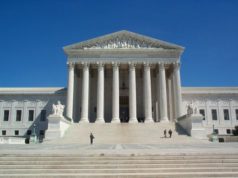Table of Contents

The United States Supreme Court is one of the most prestigious and powerful courts in the world. It serves as the ultimate adjudicator on matters of law, interpreting the Constitution and ensuring that the laws of the land are upheld. With only nine justices serving on the court, any vacancy on the bench is of great importance. The process for filling a vacancy on the Supreme Court is deeply political and highly scrutinized, and as such, can have significant impacts on the legal landscape of the country for years to come.
History of Supreme Court Nominations
The process of filling vacancies on the Supreme Court has evolved considerably since the first nominations were made in 1789. In the early days of the court, nominations were less contentious, and presidents would typically choose individuals from their own political party to serve on the bench. For example, President John Adams appointed Federalist party members to the court, while President Thomas Jefferson appointed individuals from his Democratic-Republican party to the bench.
As the political landscape of the country became more complex, so too did the nomination process for Supreme Court justices. In the mid to late 1800s, presidents began to consider factors beyond party affiliation when selecting nominees. They looked for individuals who were highly qualified, with impeccable legal credentials and a deep understanding of the law.
Since the early 1900s, there have been numerous landmark Supreme Court cases that have helped shape American jurisprudence. These include cases like Brown v. Board of Education, Roe v. Wade, and Citizens United v. FEC. With each of these cases, the nomination process for selecting judges became even more scrutinized and heavily politicized.
Vacancies in the Supreme Court
Vacancies on the Supreme Court can occur in a variety of ways. The most common reason for a vacancy is retirement. Justices on the Supreme Court are appointed for life, but they can choose to retire at any time. Over the years, many justices have chosen to retire when they feel they can no longer serve effectively or have reached an age where they believe it is time to step down.
Another common reason for a vacancy is death. While justices are typically appointed for life, they are not immortal. When a justice dies, a vacancy occurs, and the remaining justices must continue their work with a reduced bench until a replacement can be nominated and confirmed.
Finally, there are cases in which a justice may be removed from the court. This is an extremely rare occurrence, but it has happened in the past. In 1805, Justice Samuel Chase was impeached by the House of Representatives and put on trial before the Senate. He was ultimately acquitted, but the process highlighted the fact that justices, like all government officials, are not immune to impeachment and removal.
The Nomination Process
When a vacancy occurs on the Supreme Court, the President of the United States must nominate a replacement. This is a highly political process and can sometimes take months or even years to complete.
The President is not required to consult with anyone when making a nomination, but they often seek advice and recommendations from a variety of sources. For example, the President may consult with senators, legal experts, or members of the judiciary when considering potential nominees.
Once the nomination has been made, it is sent to the Senate Judiciary Committee for review. The committee will hold hearings to consider the nominee and will ultimately issue a recommendation to the full Senate. If the Senate approves the nomination, the judge becomes a justice on the Supreme Court.
The confirmation process can be extremely contentious, particularly when the Senate is controlled by a different political party than the President. In recent years, nominations to the Supreme Court have often been the subject of intense partisan debate. This was particularly true in 2016, when President Barack Obama nominated Judge Merrick Garland to the Supreme Court following the death of Justice Antonin Scalia. The Republican-controlled Senate refused to consider Judge Garland’s nomination, arguing that it was too close to the upcoming presidential election and that the American people should have a say in the selection of the next justice.
Impact of Supreme Court Nominations
The selection of Supreme Court justices can have a profound impact on the future of the country. With only nine justices serving on the court, each one has an enormous amount of power and influence over issues like civil rights, marriage equality, and campaign finance reform. For this reason, nominees are often subject to intense scrutiny and criticism.
Notably, the confirmation of Supreme Court justices can also have significant political implications. Because justices serve for life, a nominee who is confirmed to the court can shape American jurisprudence for decades to come. This means that nominations and confirmations are carefully analyzed by both parties to ensure that the nominee reflects their party’s ideology and values.
Conclusion
The process for filling vacancies on the Supreme Court is a complex and highly political one. With each nomination, parties seek to shift the balance of the court in their favor, while legal experts and the public look on with great interest. The selection of Supreme Court justices is a vitally important process, one that impacts not only the judiciary, but also the future of the United States as a whole. As such, it is important that each nominee is thoroughly vetted, and that the process for selecting a new justice remains fair.
A contentious and closely followed element of modern American politics is the Supreme Court nominee approval process, all the more so because it occurs outside the timetable of fixed deadlines and comes up only infrequently. One of the relevant issues in the selection of Supreme Court nominees is the consideration of when such a procedure is necessary.
In this regard, the United States Constitution is less helpful than might be surmised from its role in creating the institution of the Supreme Court, as it does not address the number of members to take part in the Court.
It does loosely imply the limitations on the length of time for which Supreme Court Justices may remain on the bench, which might be reasonably considered practically nonexistent in that the only stipulation is that it be “during Good behavior”.
A Supreme Court Justice can, however, choose to retire from the Court, and thereby impose the unanticipated need for selection of a Supreme Court nominee.
Though there is a mechanism for the impeachment of Justices provided through Congressional procedure, it has only occurred once, and ended in defeat, while later efforts have not even succeeded in calling for hearings.
As a measure of its strength and continuity with the original intentions of the Founding Fathers, the United States Supreme Court has experienced relatively few cases of vacancies needing to be filled throughout its history, with only 113 separate members having been appointed to the bench by 2010.
In this number, 16 people have served as Chief Justice and 97 in the subordinate “Associate” position.
Despite the fairly low number of Supreme Court nominees, most Presidents have been able at least once to submit a Supreme Court nominee of their own to fill a vacancy on the bench.
Up to the present, only President Carter has been denied the opportunity in the course of a full-term and without changes to a Court procedure to submit a Supreme Court nominee.
In this regard, the Presidential power for selecting Supreme Court nominees is considered one of the most lasting aspects of a president’s legacy.
Article II, “The Executive Branch,” provides this power to Presidents to be exercised “with the Consent and Advice of the Senate”.
The full process of hearings and approval for Supreme Court nominees is not set out under the law, but this stipulation does allow for such assorted procedures, which evolved into their modern form over the full course of the Court’s history.
The Congressional practice of questioning Supreme Court nominees first appeared in 1925 and was set as an established procedure in 1955.
The questioning of a Supreme Court nominee takes place before the Senate Judiciary Committee, which then decides whether or not to recommend a general vote on the nominee’s acceptability. After this point, however, a Supreme Court nominee may still be denied the consideration of a vote through the tactic of a filibuster or by the President’s reconsideration.
The process of approving a Supreme Court nominee has shifted over time from being essentially procedural to the highly politicized and contentious form it now takes.


























